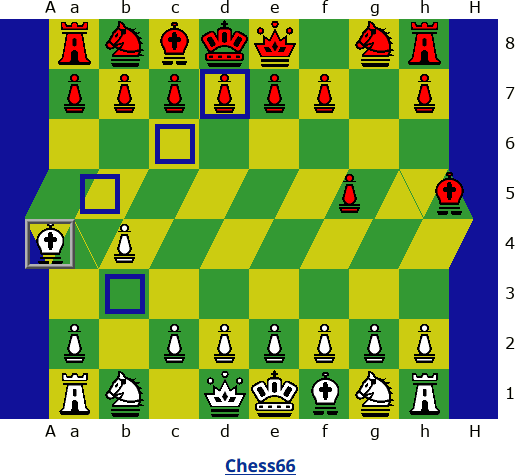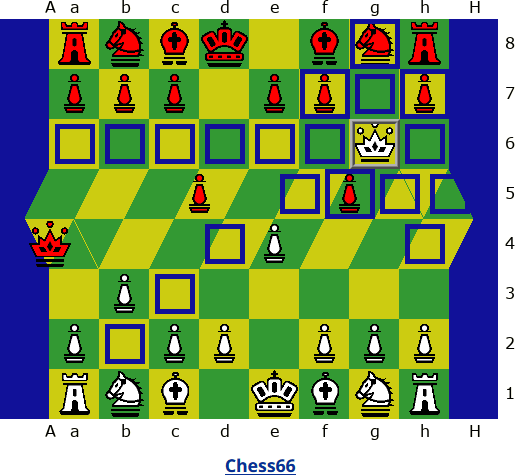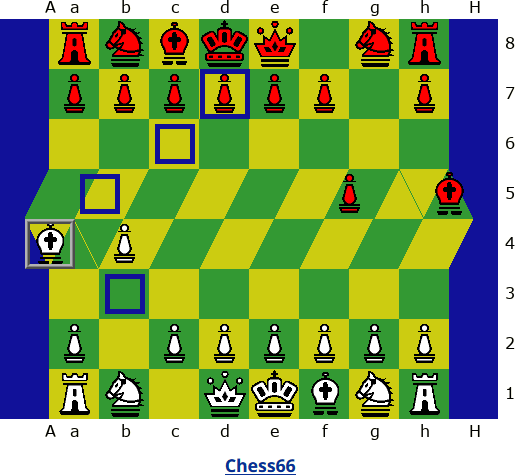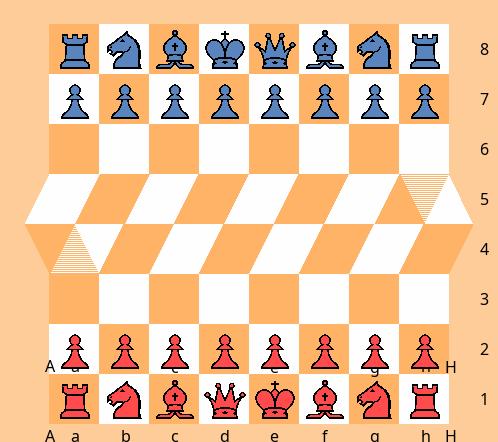Comments/Ratings for a Single Item

Using alternating horizontal lines in both colors in half of 4 and 5 instead of a dividing line seems to be a good solution.
Now, based on these, it would be legal for a Queen (or Bishop) on g6, as illustrated below, to move to either h5 or 5. Is this correct?

That is absolutely correct. The move possibilities of the queen are shown completely.
After the discussion at that time I have adapted my description. In summary it says:
- Finally, you can move into a switch from below, from the side or from above. If the switch is not occupied, then you can choose whether the piece that moves into the switch is on 4 or a4 respectively on 5 or h5 after the move. If the switch is occupied, then the piece in the switch must be captured; the opponent’s piece takes the place of the captured piece.
This diagram shows its legal moves a few moves after it has moved to 4. At this point, it may move to b3 but not back to c1. Is this all correct?

The move options shown are correct.
The possible moves of a bishop on 4 go in the direction of d1 or e8, but not to a3, b2 or c1.
Here are some examples that are not handled clearly enough in the description of the rules. The following diagram shows legal moves for the Bishop on c1. It can move to 4, though not to a4.

These moves are not possible.
The bishop on c1 can move to a3, but not into the switch. The bishop on 4 can in principle move to d1 or e8. The moves to a3, b2 or d1 are not possible. The queen on d1 can reach the switch - provided there is nothing in between. In the switch, the queen can be on 4 or a4.
 H. G. Muller wrote on Wed, Nov 9, 2022 09:16 PM UTC in reply to Fergus Duniho from 09:08 PM:
H. G. Muller wrote on Wed, Nov 9, 2022 09:16 PM UTC in reply to Fergus Duniho from 09:08 PM:That indeed removes the impression that the triangular edge parts of 4 and 5 are cells in themselves, which diagonally border a3 and h6. For the same reason I had used the same special color for all of 4 and 5 in the Interactive Diagram. In the rectified representation a4 and h5 are not distorted, and the shape is enough to suggest that they do form complete squares partly hidden under 4 and 5.
The Queen move looks fine to me.
To reduce the illusion that 4 and 5 are diagonally adjacent to a3 and h6, I have modified the board to use alternating horizontal lines of both colors in half of 4 and 5 instead of using a dividing line. This makes it look more like each pair of spaces in a switch are actually overlapping spaces.

It makes sense that all paths for Bishops and Rooks should be two-way. In this case, I neglected to unlink 4 and 5 from spaces they got diagonally linked to with map. It would help to add the following to the rules to help clarify things:
- Every path of movement for a Rook, Bishop, Queen, or King can go either way. So, for any two spaces, x and y, if one of these piece is normally capable of moving from x to y, it is also normally capable of moving from y to x.
- Orthogonal and diagonal paths of movement are mutually exclusive. Orthogonal movement is permitted between spaces sharing a side, and diagonal movement is permitted only between spaces that share a single corner but no sides. So, between 4 and a4 or between 5 and h6, only orthogonal movement is allowed, and between 4 and b3 or between 5 and h6, only diagonal movement is allowed.
Now, based on these, it would be legal for a Queen (or Bishop) on g6, as illustrated below, to move to either h5 or 5. Is this correct?

 H. G. Muller wrote on Wed, Nov 9, 2022 07:18 PM UTC in reply to Fergus Duniho from 06:14 PM:
H. G. Muller wrote on Wed, Nov 9, 2022 07:18 PM UTC in reply to Fergus Duniho from 06:14 PM:As I understood it only the second is correct. All moves are reversible in this game (except for Pawns, of course). The squares a3 and 4 have an edge in common, so going between those would be an orthogonal step, not allowed for a Bishop. Both 4 and a4 connect diagonally to b3, as they both have only a corner in common with the latter. (Not clear from the picture is that 4 and b4 share an edge.)
The Interactive Diagram I posted in the Chess69 topic thread (which has a similar switch) should show the correct moves for Bishops and Rooks. (Not for King, though!)
This game has a paradoxical nature, because some pairs of independent spaces also function as though they are the same space. Due to this paradoxical nature, confusions about the rules can easily arise. This makes it all the more important to clarify the rules in detail. It is not enough that the rules seem clear and complete to its creator. The standard to be met is that they seem clear and complete to other people, and particularly to programmers, who have to anticipate every possible move ahead of time.
Here are some examples that are not handled clearly enough in the description of the rules. The following diagram shows legal moves for the Bishop on c1. It can move to 4, though not to a4.

This diagram shows its legal moves a few moves after it has moved to 4. At this point, it may move to b3 but not back to c1. Is this all correct?

@ Fergus Duniho
Thor Slavensky wrote on 2022-10-23 CEST Good ★★★★
This is a great idea with those switches. Together with the twisting of the files it makes a very interesting board and game. The switches give instantly the game a dynamic tension which is enjoyable. And a very sophisticated solution that 2 squares together constitute 1 field on which there can only be 1 piece. There is no mentioning of pawn move/capture (maybe it could be helpful), but it must be implied that 'normal' forward movement and diagonal capturing are in place, that will often be first 'battle' around the switches.What is better than 2 switches? That has to be 4 switches! The inventor, Gerd Degens, has also such a game, Chess69, which can be viewed through the link at the top, or for CVP members through the link in the comments. I will try to make a comment about it later. But I can only recommend to the editors that this game also is published properly. It is even more interesting because here the ranks are also twisted, very delightful for us fans of 'unusually shaped boards'. It already has a old post from 2003 here on CVP with a broken link in the Alphabetical Index and the Topic Index, so that will have to be displaced.
Chess 69 is the follow-up to Chess 66; Chess 66 has already been published properly. Thanks in advance.
Thanks Thor for the flowers. For those interested: Chess69
This is a great idea with those switches. Together with the twisting of the files it makes a very interesting board and game. The switches give instantly the game a dynamic tension which is enjoyable. And a very sophisticated solution that 2 squares together constitute 1 field on which there can only be 1 piece. There is no mentioning of pawn move/capture (maybe it could be helpful), but it must be implied that 'normal' forward movement and diagonal capturing are in place, that will often be first 'battle' around the switches.
What is better than 2 switches? That has to be 4 switches! The inventor, Gerd Degens, has also such a game, Chess69, which can be viewed through the link at the top, or for CVP members through the link in the comments. I will try to make a comment about it later. But I can only recommend to the editors that this game also is published properly. It is even more interesting because here the ranks are also twisted, very delightful for us fans of 'unusually shaped boards'. It already has a old post from 2003 here on CVP with a broken link in the Alphabetical Index and the Topic Index, so that will have to be displaced.
After contact with Ben Reiniger - see comments below - I have adapted my description of the variant 'Chess 66'.
New is that in switches can be operated as follows: It is possible from below, from above and from the side equally to move into the switch and that independent of the direction of the move the squares of a switch can be reached separately (4 or a4 respectively 5 or h5).
It would be nice if the editors of CVP would read my description again crosswise to finally arrange for a publication. If 'Chess 66' should be published, then 'Chess 69' seems to be published as well.
To start with point (2): This is clear that a rook on a8 cannot move to a3...a1 if a switch is occupied.
Regarding point (1), I already had doubts yesterday. According to my imagination so far, the squares of a switch (e.g. 4 and a4) can only be reached from a1...a3 or from rank 4. In my description I assume that a bishop starting from e8 can only reach square 4 of the switch and not a4. This affects a rook/queen on a8 in the same way.
But in this case it means that a move into the switch cannot be done if a piece is on a4, because then the squares 4 and a4 would be occupied together - which would not be in accordance with the rules. But this does not seem very logical.
Therefore, I think that a pragmatic solution for switches should be used.
If the switch should not be occupied, it is possible to move into the switch from above, from below or from the side, whereby either field 4 or a4 respectively 5 or h5 can be occupied.
In case the switch is occupied, the piece in the switch must be captured when the opponent's piece moves into the switch; the opponent's piece takes the place of the captured piece.
This means for your point (1): The rook on a8 can capture the piece on a4, and then it stands on a4.
This also means that a bishop on e8 can reach either square 4 or square a4. If a4 is chosen, then the next move can be towards f8 or towards d1. I think that such an procedure simplifies the rules and makes the game easier to play. What do you think?
Perhaps a remark about 'Avatar Chess'. The variants you mentioned (Lumberjack, Smess) were not known to me before. In normal chess, a piece has a fixed skill level, which means that during the game two kings, two queens, four rooks, etc. define the game. In Avatar Chess it is possible that up to 6 queens, 12 rooks etc. are in play - of course rather theoretically and then only for a short time. I think that this could be interesting.
 Ben Reiniger wrote on Mon, Jul 18, 2022 03:02 PM UTC:
Ben Reiniger wrote on Mon, Jul 18, 2022 03:02 PM UTC:That helps, yes. To be explicit about the "last" question in each case then, the answer is "not"? My piece on a4 (1) cannot be captured by and also (2) blocks movement (to a1...3) of an opponent rook on a8?
Thanks Ben for the questions, here it should be clearer in the description (although it is already described between the lines, but that is probably not enough).
When capturing on a switch, first assume that there can be only one piece on a switch (here I differ from Fergus Duniho's Reroute66, a variant of my idea). So, for example, if a rook or queen starts from a1...a3 or from rank 4 and the switch is not occupied, then either square 4 or square a4 can be occupied in the switch.
But there is no choice if the switch is occupied by a piece. If a rook or a queen moves from a1...a3 or from rank 4 into the switch, then the piece in the switch must be captured (because two pieces on the switch are not possible). If the piece was on square 4, then the opponent's piece is on square 4 after the move has been executed (applies to a4 in the same way).
Furthermore, an occupied switch cannot be jumped over and a direct change from 4 to a4 (vice versa a4 to 4) is not possible - differently in Reroute66.
Have I understood the question correctly and hopefully answered it correctly? I would be glad.
 Ben Reiniger wrote on Sun, Jul 17, 2022 09:00 PM UTC:
Ben Reiniger wrote on Sun, Jul 17, 2022 09:00 PM UTC:I didn't really follow the discussion on this variant earlier, but gave the page a fresh read. I think I mostly get it now, except how capturing on a switch works. It might be clarified in the comments, but it should be made plain in the page text as well. (Perhaps it is there too and I have missed it and/or it wasn't quite clear enough.)
Let's say I have a piece on 4, and the opponent has a piece that can otherwise move to a4 but not 4. Can they capture (and if so where do they end their move) or not (if not, could they potentially continue moving through a4 past my piece? I'm not sure that makes sense for any piece at the edge of the board like this, so probably moot, but I'll ask in case)?
Same question reversing 4 and a4. (Now the last question certainly can apply, e.g. the opponent piece is a rook on a8.)
What about 'Chess66'? Do you want to publish it - or possibly not and why not? If you don't want to continue with 'Chess66', then it won't work with 'Chess69' either. Anyway, then try the variant 'Avatar Chess' , which I think is programmable. Thanks in advance.
If I may intrude into the discussion of how pieces are named and refer again to my variant 'Chess 66'. We have discussed Chess 66 and clarified inconsistencies. For my part, I have taken up the suggestions in my description by adding explanations and clarifying examples. The functionality of the switches as I imagine it is not compatible with Fergus 'Reroute 66' (occupied switsches can be skipped, switching between fields of switches is possible). This should be discussed. Therefore I would have the request to publish my variant 'Chess 66'. Are there any reasons against it?
I'm looking at the diagrams on my Likebook Mars at night, and on its monochrome e-ink screen, I cannot tell apart the red and blue pieces in the diagrams. At best, they are slightly different shades of black. In the diagram I made, the red pieces, which belong to White, appear even darker than the blue pieces, which belong to Black, which is opposite to how they should look in black and white. For the sake of accessibility for color-blind people and people using e-ink displays or black and white printouts, piece colors with more light/dark contrast would be more suitable.
I am very impressed, the changed look in Game Courier is a real enrichment. I am sure that many things can be better represented on this basis. I hope that I am not going too far out on a limb when I say that a variant such as Avatar Chess can be better conveyed. A very interesting upgrade.
I have been working behind the scenes to get Game Courier and the drawdiagram.php script to display images better. They can now recolor loaded images for the grid shape, and they can display coordinates above selected boards, which is important for Chess66, because it helps dispell the illusion that a vertical line of movement begins and ends in the same file. Here is the closest it can now come to the diagram that appears in the article. I suppose I should work on options to recolor the pieces, since what I'm doing for this diagram is using a piece set with four colors of pieces and using different labels for all of the Red pieces.

Here's are some guidelines to use in revising your description of the game.
-
The rules should be made entirely clear in the written text. Illustrations should be used to illustrate what the text has already said, not to provide additional information that is not written down.
-
The text should describe not only what can be done but how to do it.
From the questions and expressions of confusion you got regarding what the rules are, it should be evident that you have not described them clearly enough. Also, you seemed to change your mind about some details in the comments. So, you should rewrite your rules to reflect anything you have changed your mind on and to supply the details that someone would currently have to read the comments to find out about.
"...once you have settled on the rules and have described them clearly."
With respect for the great job you are doing, but I can't accept that I haven't set the rules and described them clearly. You can have different perspectives, for example regarding the functionality of the switches. It is also possible to designate parts of it as non-essential. But it is not decisive what can be programmed with the available possibilities. It's a question whether the game can be played with my rules and that the rules are consistent. I had to move concerning the access to the switches because my rules weren't clear. That's it from my point of view. Had to be said. :)
I'm excited to see what happens with my other variants (Chees 69, an addition to Chess 66 and Avatar Chess).
25 comments displayed
Permalink to the exact comments currently displayed.

Does a Pawn on a2 or h7 have an option concerning which space it goes to in a double move? If so, details about this and the effect it has on en passant should be included.